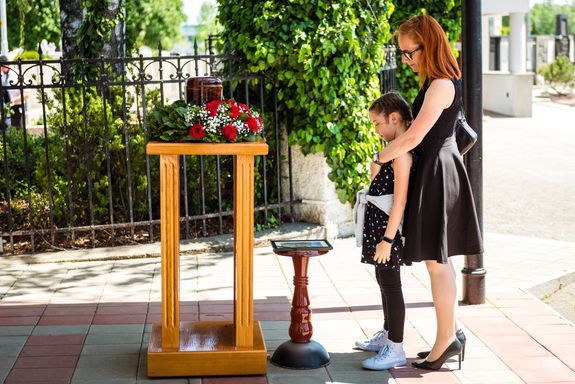Understanding Cremation Costs: A Comprehensive Guide
If we’re fortunate, planning a loved one’s disposition is rare. Rare, but inevitable, and one of the primary concerns with disposition is the cost. Traditional funerals and burials have become much more expensive over the decades, pressuring the market into providing a less costly but still dignified option.
For many families, that alternative is direct cremation. In this guide, we’ll address how direct cremation minimizes disposition expenses. We’ll also take a look at the other cost-related factors involved in a loved one’s final arrangements.
Funeral and Burial, Traditional Cremation and Direct Cremation: A Quick Cost Comparison
First, a high-level look at disposition costs. Here’s how traditional funerals and burials, traditional cremations, and direct cremations stack up:
- Traditional funeral and burial – The price of a traditional funeral and burial varies greatly across the country, and even across each state.
According to the National Funeral Directors Association (NFDA), the average price of a traditional Florida funeral is about $6,500. Between Miami and Orlando, average funeral costs differ by almost $1,000.
This also does not include the cost of a casket or cemetery plot – both of which are necessary for most burial practices. These two can add another $2,000 to $2,500 to the final cost. In all, families can expect to pay upwards of $9,000 for a traditional funeral service with burial.
- Traditional cremation – According to the NFDA, cremation with a traditional memorial service costs around $7,000. Most of this expense is tied up in the ceremony itself, as cremation services themselves are generally cost-efficient.
The traditional cremation process is similar to a traditional funeral with burial. The funeral home is rented out for the memorial, and there may be a viewing prior to disposition.
- Direct cremation – With direct cremation, there is no traditional remembrance ceremony or viewing prior to disposition. Services include retrieving the decedent’s body from the place of death, transporting the remains to the mortuary and crematory, preparing the necessary authorization forms, and guiding clients through the process. An alternative container is provided for the decedent’s remains during cremation, and a second container is provided for the resulting cremains.
The only goods and services involved are those absolutely necessary to carry out cremation. As a result, direct cremation prices are much lower. In Florida, the average cost of direct cremation is about $1,500, but this figure is lower for many, as it includes optional goods and services.
Three Services and Goods That Drive Up Cremation Costs
The price difference between traditional cremation and direct cremation is stark. It can be greater than $5,000, in some cases. Why does the type of cremation make such a big difference?
- Funeral home and staff costs – The biggest expense, by far, associated with traditional cremation is the cost of the funeral home staff and space. Together, staff and venue fees can run up to $4,000 or more. When a family works with a funeral home, these fees are unavoidable.
- The cost of cremation casket – During a traditional cremation with viewing, the decedent is placed in a ceremonial casket. This casket is typically of durable, quality construction – the kind that would normally be used with a burial. For most traditional cremations, though, the casket is only rented and will not be passed into the cremation chamber with the decedent. That rental will cost up to $1,800 or more.
- The cost of embalming and cosmetics – Embalming is required with a traditional viewing, as this preserves the body long enough for the viewing to take place. Additional cosmetic services may also be necessary to present the deceased in a dignified manner during the memorial service. Embalming and cosmetics don’t impact the final price as much as other funeral service fees, but they can still run several hundred dollars.
Embalming and cosmetics are not required for direct cremation, as the body is placed in refrigeration prior to cremation.
Families Can Add Items, Like an Urn, to Their Direct Cremation Services
As budget friendly as direct cremation is, there’s still room for flexibility, and many people do decide to add in certain goods and services. For example, the following options are available:
- A cremation casket
- An urn (available in many designs and materials)
- Delivery or mailing of decedent’s cremains
- Expedited or rush cremation services
While these can increase the cost of direct cremation, they can help with informal remembrance ceremonies and are therefore popular additions to direct cremation plans.
Another Cremation Cost Factor: What Families Do with the Ashes Following Cremation
One of cremation’s primary advantages is its flexibility. With cremation, people have additional post-disposition options, so families can choose to remember their loved one the way they choose. Some of those options include:
- Scattering or burying the ashes in a beloved spot – Many families choose cremation so they can scatter or bury their loved one’s cremains in a favorite spot. This could be on the decedent’s own property, at a park, over the water, or any place of personal significance.
This approach is generally cost-free, and Florida ash-spreading regulations are relaxed. However, you’ll need permission from the property owner before ashes can be scattered or buried in the area. Also, if the cremains are to be scattered over the water, you may need to rent a boat, as Florida laws require scattering to occur a certain distance away from the coast. If you’re planning on scattering ashes in a public park, a permit will likely be required and the typical cost is up to $75.
- Scattering the ashes at a scattering garden – Some cemeteries have space reserved for a scattering garden, where families can spread their loved one’s ashes in a cultivated, beautiful space. Costs start at around $100 and may run up to $1,000, as a plaque, bench or other memorial with the decedent’s name can be included with scattering.
- Burying the urn in an urn garden – Some cemeteries also have areas designated for burial urns. Termed urn gardens, these spaces include smaller burial plots designed for urns, so they cost less than a traditional burial plot. Along with the burial plot, urn gardens may include a memorial plaque or headstone. The cost of burial in an urn garden is usually several hundred dollars, with most of that going to the plot itself.
- Storing the urn in a columbarium or vault – There are also above-ground interment options for cremation urns. These include vaults and columbariums, which are specifically designed for urns. Interment spaces range in size – some are only large enough for a single urn, while others are large enough for an entire family.
There’s also a big range in cost. An exterior-facing, single space vault may only cost a few hundred dollars. A family-sized space inside of an ornate columbarium, though, usually costs a few thousand dollars or more. In densely populated areas and in high-demand cemeteries, the price can be over $10,000 for a space.
Funeral and Cremation Costs Are On the Rise, But Direct Cremation Provides a Mix of Affordability, Flexibility and Dignity
Most types of disposition come with serious sticker shock. With funeral home services, rentals, and caskets all climbing in price, the traditional funeral is out of reach for many families.
Fortunately, traditional funerals represent only one disposition option among many. Cremation, and direct cremation specifically, offers the dignity that comes with a traditional funeral. And it also offers the flexibility and lower cost that many families require.





